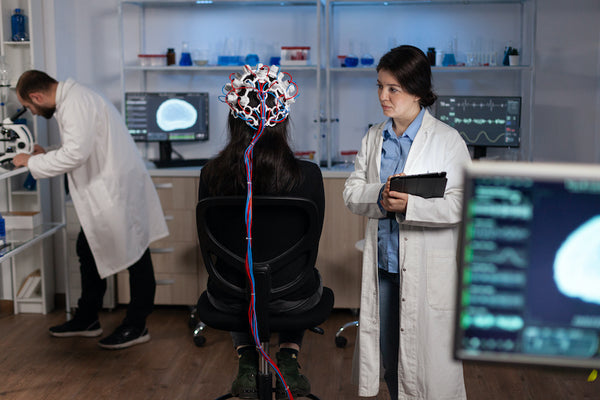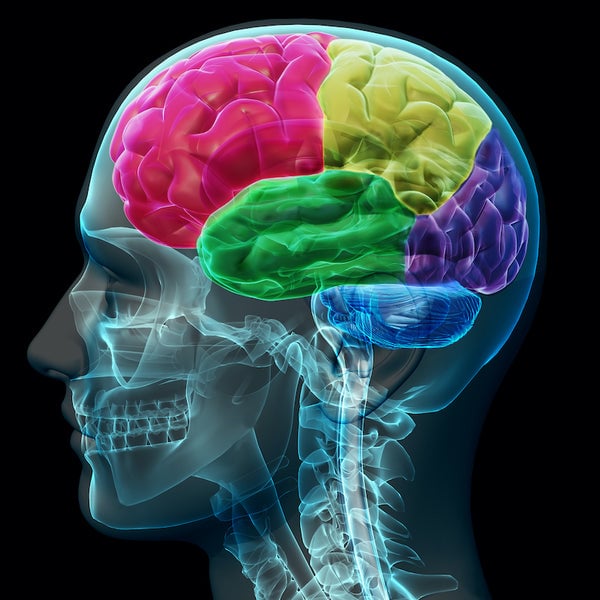4 min read Preserving the integrity of our hearing faculties is of paramount importance. As we age,...
What Part of the Brain Controls Hearing?
4 min read
When you stop and think about it, our brain’s ability to turn noise into sounds we can understand is truly amazing. We all know that sounds travel through our ears and brains. But what part of the brain controls hearing?
What Part of the Brain Controls Hearing?
While our ears hear, it is our brain ‒ and more specifically, our auditory cortex ‒ that does the listening. Your brain controls hearing and lets you make sense of all the sounds traveling through your ear. It also allows you to understand speech, communicate, appreciate music, and enjoy the sounds of nature. In this article, we will discuss the amazing pathway of hearing that occurs to answer the question, “What part of the brain controls hearing?” If you are struggling with your hearing, you might wonder if you need hearing aids. We can help you answer that question, too.
The Part of the Brain That Controls Hearing

Our brains are wired to make sense of all the sounds that travel through our ears. Perhaps you have heard the saying, “You hear but don’t listen.” While our ears are responsible for hearing sounds, it is up to our brains to understand and comprehend the sounds we hear.
The Auditory Cortex in the Brain's Temporal Lobe
The auditory cortex in the brain's temporal lobe is responsible for processing sound signals sent from the auditory nerve. This amazing region interprets and understands the different elements of sound, like pitch, tone, and frequency. Thanks to this complex processing, the auditory cortex helps us differentiate sounds and recognize speech.
But the journey of sound doesn't end there. The pathway of hearing within the brain is even more fascinating.
The Pathway of Hearing
The auditory pathways process and decode sounds and turn them into something you recognize, like a honking horn, your favorite song, or a question. Here is how sound travels from your ear to your brain:
Sound Waves Enter the Ear
First, sound enters the outer ear, which is also referred to as the pinna. The pinna filters and amplifies sound waves and sends them down the ear canal. Next, sound waves hit the eardrum, also called the tympanic membrane. The eardrum essentially vibrates as soon as sound waves hit it.
Sound Moves Through the Middle Ear
Behind the eardrum is the middle ear. Sound waves are amplified in this part of the ear before they are delivered to the inner ear. Here it happens: your eardrum is attached to a chain of three small bones, called the auditory ossicles. Those three bones are the smallest ones in your whole body! When the eardrum vibrates, these bones are set into motion as well. The three ossicle bones have three names. The ossicle bone directly attached to the eardrum is the malleus, aka the hammer, which is connected at its other end to the incus, aka the anvil. The incus is attached to the stapes, aka the stirrup or footplate. The stapes is connected to the oval window. The oval window is a membrane separating the middle ear from the inner ear. These three bones function as a lever and amplify the sound energy as it moves from the larger tympanic membrane to the smaller oval window.
Sound Moves Through the Inner Ear
The vibrations from the stapes push on the oval window, and set up pressure waves in the fluid-filled cochlea, aka the inner ear that contains the organ of Corti. In the organ of Corti, vibrations are turned into electrical energy by hair cells. Different frequencies stimulate these tiny hair cells lining the cochlea. You may have heard of high-frequency hearing loss, which means it is more difficult to hear high-pitched sounds. The hair cells that detect high frequencies have been damaged in this case. While low-frequency and mid-range hearing loss are also possible, they are much less common. A frequency hearing test can determine the highest frequency you can pick up.
The Auditory Area of the Brain Interprets the Sound
Finally, once the sound is converted to electrical signals in the cochlea, these signals travel along a complex circuit of nerve pathways to the auditory cortex and other auditory areas of the brain that regulate awareness and sensory perception. Brain cells called sensory neurons communicate sound information to the various parts of the brain, including the auditory cortex, temporal lobe, and thalamus.
Many Parts in the Brain Control Hearing
The answer to “What part of the brain controls hearing?” is quite complex. Many parts of the brain are responsible for interpreting and receiving sounds. Exactly how our brains process sound is still being investigated by researchers today.
Common Issues With the Pathway of Hearing

Because the hearing process is so elaborate, it’s no surprise that sometimes things go wrong and can reduce your ability to hear. Several types of hearing loss can occur along the pathway of hearing, including:
Conductive Hearing Loss
Conductive loss is defined as hearing loss that occurs when sounds do not make their way through the outer or middle ear.
Sensorineural Hearing Loss
This is the most common type of hearing loss and happens when the tiny hair cells in the inner ear or the auditory nerve are damaged. Sensorineural hearing loss includes age-related and noise-induced hearing loss.
Mixed Hearing Loss
Mixed hearing loss is a combination of conductive and sensorineural hearing loss.
Auditory Disorders
Several types of hearing loss, called auditory processing disorders, happen within the auditory nerve and brain.
Since there are different types of hearing loss, it makes sense that there are different types of hearing aids. It is important to find the best hearing aids for you and your particular hearing loss.
A Hearing Aid Can Help The Part of Your Brain That Controls Hearing
Hearing aids are transformative for anyone with hearing loss. Hearing aids are also easier to obtain now that you can purchase over-the-counter hearing aids online from Soundwave Hearing. If you think you might benefit from a Sontro® OTC hearing aid, take our free online hearing test today!


